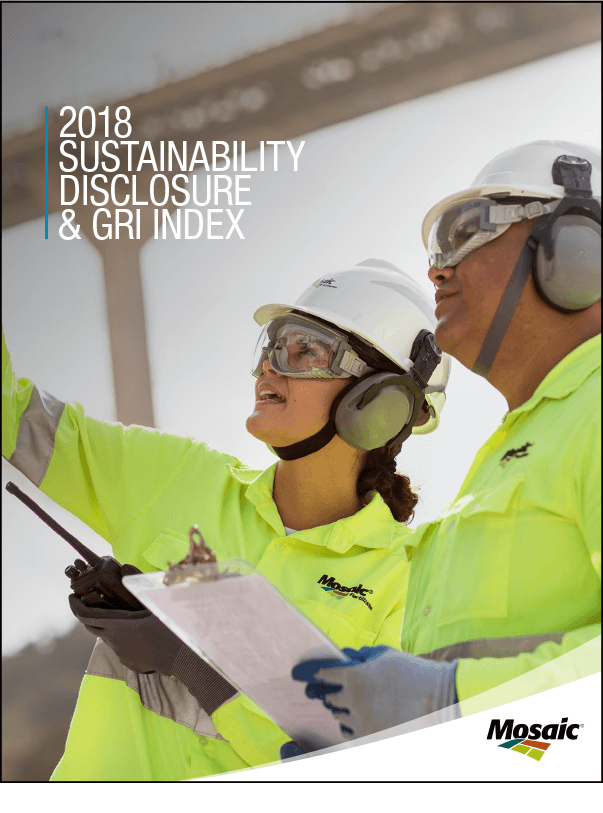ENVIRONMENT
2018 SUSTAINABILITY HIGHLIGHTS
Progress in Responsible Stewardship
Respect for the natural environment is essential to the sustainability of our business. From our potash mines in Saskatchewan, to our Florida phosphate operations, to our mining, distribution and blending facilities in Brazil, we strive to optimize our production processes and reduce our environmental impact.
In addition to being heavily regulated by numerous agencies in each of our operating areas, our management of environment issues—including water, energy and greenhouse gas emissions and waste—is influenced by Mosaic’s guiding principle of responsibility, Environmental, Health & Safety Policy and commitment to the United Nations Global Compact and Sustainable Development Goals.

Our Commitment to Responsible Dam Use
Following January’s Vale dam failure at Brumadinho, the Brazilian government enacted new regulatory requirements for tailings dams in Brazil. In response, Mosaic Fertilizantes idled three mines to ensure they continue to operate safely and meet all new requirements. Our mines in Brazil have passed extensive testing and regulatory requirements in the past and they do not present imminent risks. Mosaic remains committed to doing everything in our power to act responsibly and make sure that we keep our people, our communities and the environment safe.

At a minimum, we conduct acre-for-acre reclamation of phosphate-mined lands for use by wildlife and people. Our reclamation plans begin long before mining ever starts.
Proactive, meticulously planned reclamation
We take pride in advancing the science and practice of reclamation in the U.S. At a minimum, we conduct acre-for-acre reclamation of phosphate-mined lands for use by wildlife and people. Many of our reclaimed lands are now home to beautiful local and state parks that anyone can explore, but it’s the neighboring residents who spend the most time fishing, camping, biking, jogging and playing while observing the abundant wildlife that make these areas their home.
In 2018, Mosaic reclaimed nearly 250 acres of wetlands and constructed approximately 3,250 linear feet of streams in Florida.
The biology behind reclamation efforts
Our reclamation teams, comprised of biologists, ecologists, engineers and other professionals, implement state-of-the-science design techniques to create high-quality habitats—ranging from prairies and forests to wetlands and lakes. The steps we take, like reintroducing the original topsoil to the wetland, allow native wildlife and plant species to truly thrive. Often, our practices enhance wildlife corridors by connecting reclaimed wetlands to existing preservation wetland systems. In some cases, even past environmental damage like wetland draining and filling, unrelated to mining, can be corrected.

We take pride in advancing the science and practice of reclamation in the U.S.
Stream construction
A stream’s function within a watershed is complex, so Mosaic uses sophisticated stream modeling techniques and simulated flood-flows to create the design. This allows us to ensure proper hydrological function to the systems they connect, wildlife corridors and aquatic habitats.
We also slope and plant grasses, shrubs and trees on stream banks to develop stable wetland floodplains that connect to adjacent upland areas. These transitional areas provide a critical link between the uplands that rise above them and the wetlands that are replenished by them. Because these transitional areas serve as a gateway to adjoining ecosystems, our reclamation teams develop vital floodplain buffers needed for wildlife and plant life to thrive.
Mosaic is proud to be a leader in developing and applying techniques to return mined lands to wildlife and people. We believe our efforts not only allow for ecological restoration, but also provide a sense of pride to the Florida residents who admire the natural beauty of their state.

Water At the Center
We recognize water is a critical natural resource that is essential to the sustainability of our operations, as well as the communities and ecosystems in which we operate. In our direct operations, we consume significant volumes of water in the mining and production of our phosphate and potash crop nutrient products. The primary sources of water for our operations are surface water; rainwater, used as alternative water supply; and groundwater. Our facilities monitor and evaluate water use to confirm it is minimized, and water recycling and reuse are maximized. Secondary sources of water include water supplied by local authorities and partially treated industrial and domestic reclaimed water, also supplied by local authorities.
As it relates to the use of our products, crop nutrient products like those Mosaic manufactures have the potential to run off farmland and into waterways, which can impact water quality. By preserving the quality of water, minimizing our own water use, and supporting and promoting nutrient stewardship practices, we are reducing the environmental impact of fertilizers on the global water supply.
Broadly, our water stewardship efforts are focused on
- Preserving and maintaining the quality of the water we use in the communities where we operate
- Promoting the 4R Nutrient Stewardship framework to minimize the impact of crop nutrients on waterways
- Maximizing water recycling and reuse
- Monitoring and evaluating our water use and driving facility-level conservation efforts
- Developing partnerships with industry and government to use alternative water sources
- Reporting performance and communicating with stakeholders
Environment/GHG
Employee Spotlight

Name
Jessica Theriault
Title
Dir. Environmental Affairs, Potash Operations
Years at mosaic
21
Location
Saskatchewan, Canada
Since 2015 we’ve reduced emissions approximately 10% from 2012 levels. Moving forward, we are committed to continuing to reduce our GHG footprint through energy management, innovation and automation.
Jessica Theriault
Our interview with Jessica
Q. What is the greenhouse gas/energy efficiency landscape like in Canada right now?
A.Canada has announced plans to reduce emissions countrywide by 30% from 2005 levels in an effort to address climate change. In response, we’ve seen increased scrutiny around industrial greenhouse gas emissions (GHGs) in the province of Saskatchewan where we operate, much like there is around the rest of the world. The pressure is on companies like Mosaic to respond, and the call to action is clear: We must adapt to changing expectations, continue to improve our operating efficiency and ultimately reduce our GHG emissions footprint.
Q. How is Mosaic responding to shifting expectations, and what role have employees played in improving efficiency?
A.We’ve always been focused on operational efficiency and environmental stewardship, but we’ve been working in earnest toward GHG reductions since 2015. In my role as Director of Environmental Affairs, it has been very exciting to see our employees rise to the challenge and contribute to the reduction of GHG emissions—with impressive results. For example, each of our Potash facilities has a Sustainability Site Lead who acts as the “eyes and ears,” in addition to their existing role, for the business. These employees lead brainstorming sessions, regularly report sustainability progress to employees and management of all levels, and lead projects that deliver progress. In one such project, teams at our Esterhazy site converted a booster pump station from diesel to electric. Not only does the conversion save in fuel consumption and emissions, but it also reduces potential environmental and safety incidents. In another project, crews programmed underground belts to shut down when they’re not conveying product. Projects like these, while in some cases considered “small” on their own, add up to meaningful savings.
Since 2015 we’ve reduced emissions approximately 10% from 2012 levels. Moving forward, we are committed to continuing to reduce our GHG footprint through energy management, innovation and automation. Read more about K3 and our automation updates.
Q. Why is this issue relevant to Mosaic’s success?
A.The successful management of GHGs ultimately affects our social license to operate; our costs; and our financial, safety and environmental management. We have a role to play in addressing this critical global challenge, and we are committed to fulfilling our mission to help the world grow the food it needs—all while minimizing our environmental footprint.
Q. In what ways have you seen Mosaic’s sustainability priorities and progress evolve since you’ve been at the company?
A.The biggest change has been the increased number and depth of conversations—discussing sustainability is included at every stage of every project, at every site and at all levels in the company. It’s not just talking the talk, either. Ideas that result from these conversations are being implemented and shared across sites as best practices. With more conversations come more opportunities, and with more opportunities come more active engagement. I’m excited and optimistic for the future of sustainability in the company and in our communities!
 2018 Sustainability Disclosure & GRI Index
2018 Sustainability Disclosure & GRI Index
Download Printable PDF >
Reporting and transparency have been integral to Mosaic’s sustainability journey. For a full list of our voluntary reporting efforts, please visit our website. View our 2018 Sustainability Disclosure & GRI Index to learn more about our sustainability progress.